Archive for the '1940s Hollywood' Category
Sleeves
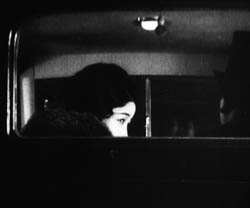
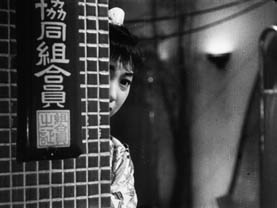
DB here:
Earlier this month, when I was giving a lecture on Mizoguchi Kenji at our university museum, I showed two images from A Woman of Rumor (Uwasa no onna, 1954). It’s a little-known film of his, and it’s probably not up to his finest, but seeing the stills again on the big screen made me want to write about one scene. That scene displays aspects of Mizoguchi’s artistry that I touch on in one chapter of Figures Traced in Light and in the website supplement here.
This blog entry constitutes, I suppose, another supplement. After all, I couldn’t include in the book all the moments in Mizoguchi’s work that I find fascinating. But since comparison is a good way to get under a movie’s skin, my examination of a parallel scene from another movie may have more general interest. Even though Woman of Rumor doesn’t seem to be available on video, maybe looking at this pair of examples would inspire some readers to take an interest in one of the two or three greatest filmmakers who ever lived.
In the court of Regina
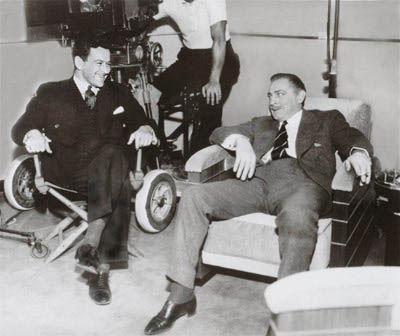
William Wyler and John Barrymore.
What a year 1941 was in the American cinema! We remember it for Citizen Kane but it also brought us How Green Was My Valley (a better film than Kane, I think), and items like Sergeant York (the biggest box-office hit), Dumbo, The Philadelphia Story, Suspicion, Ball of Fire, High Sierra, The Lady Eve, Meet John Doe, The Maltese Falcon, They Died with Their Boots On, and one of the most daring movies ever made in America, The Little Foxes.
An adaptation of Lillian Hellman’s play, The Little Foxes offers a study in unbridled capitalism. It shows how economic interests pit the South against the North and white against black. Psychologically, it analyzes a household gripped by the ruthless domination of the matriarch Regina (Bette Davis), the wiliest member of a family of grasping entrepreneurs. Regina has all but flattened her husband and is trying to make her daughter Alexandra oblivious to the family’s corruption.
The Little Foxes was also bold in its style—in its own way, as venturesome as Citizen Kane. It hasn’t been fully appreciated because Wyler is still thought of as a rather middlebrow talent, an overcautious director who toned down the flamboyance of Gregg Toland’s deep-space and deep-focus compositions.
Some day I hope to blog in defense of Wyler, middlebrow movies, and Midcult art in general. That would involve a detailed analysis of Little Foxes. (1) For now let’s just say that Wyler’s direction of the film won the admiration of no less than André Bazin. Bazin taught us to appreciate Wyler’s work, though with some prompting from Wyler and Toland (as I suggest here). Wyler was also appreciated by Mizoguchi, who, apparently grudgingly, told his screenwriter Yoda that he admired Wyler’s use of the “vertical frame.” (2) Later I’ll suggest one way of understanding that phrase. Mizoguchi met Wyler at the 1953 Venice Film Festival, when Ugetsu Monogatari was up against Wyler’s Roman Holiday for the Silver Lion.
One scene not discussed by Bazin or Mizoguchi, as far as I’m aware, has always gripped me. Regina’s brother Oscar has a wife, Birdie, who has turned into a passive alcoholic. Birdie has learned of plans to marry Xan off to Leo, her shallow son. Her will has been broken by Regina and Oscar, but she summons up the courage to blurt out to Xan that she mustn’t marry Leo, no matter how strongly the family insists. Xan, who has no inkling of how her family twists people to suit their ends, protests that no such thing could happen. But Oscar overhears Birdie warning Xan off.
Birdie and Oscar are about to leave at the end of the evening. Wyler begins with a standard two-shot, very slightly off-center. But as Birdie frantically warns Xan, Oscar’s sleeve and pant leg appear in the lower left of the frame, with the swagged curtain at the doorway hiding his face.
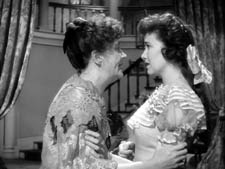
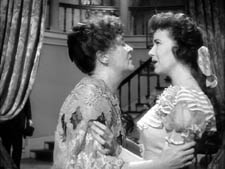
For us, this creates suspense. Only after Birdie has babbled out her warning do the two women notice he’s there. Xan, not knowing how Oscar abuses Birdie, heads off to bed.
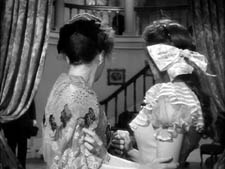
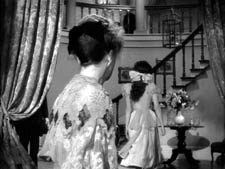
As she climbs the staircase (very important in the film and the original play, this staircase) and heads off to her bedroom, Wyler’s camera arcs to reveal Oscar. Wyler now cuts to show, more or less from Birdie’s point of view, Xan going into her room.
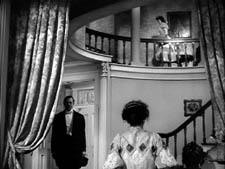

Birdie watches anxiously, then turns to face Oscar, with a look of resigned apprehension.
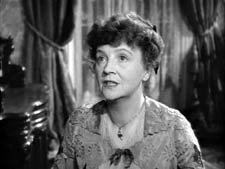
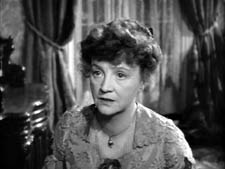
Again suspense: Oscar won’t punish Birdie with Xan watching, but the girl’s departure puts Birdie in jeopardy. In addition, Wyler’s shot of her reaction anticipates the wrath she’ll face. (Patricia Collinge’s fluent performance is equal to the dynamics of Wyler’s visuals.) These cuts anchor our empathy; Wyler has been saving the close-up of Birdie for this moment.
We return to the master framing as Birdie heads toward Oscar, passing into a patch of shadow. As she does so, he raises his hand abruptly.
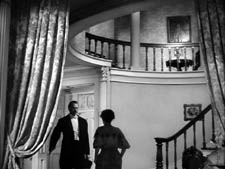
Wyler cuts to a two-shot. Oscar slaps Birdie so hard she seems to bounce against the left frame edge. She cries out and then tries to stifle her voice—a psychologically apt gesture for this woman who muffles her sorrows throughout the film.
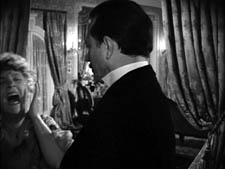
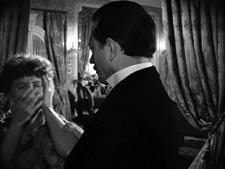
Again, Wyler daringly sets a key action off-center. The brutal discontinuity of the cut, which crosses the axis of action and sharply changes shot scale, accentuates Oscar’s violence. It’s also rather elliptical; run the cut slowly, and you never see his hand strike her.
Xan hurries out of her room and comes to the banister, her face on the upper right balancing the placement of Birdie’s in the prior shot. In the next shot, we see, over her shoulder, Oscar stride out. Birdie follows meekly, assuring Xan that nothing’s wrong. The coda of the scene will emphasize Xan’s puzzled anxiety, a phase in her process of coming to understand the domineering fury that rules her family.
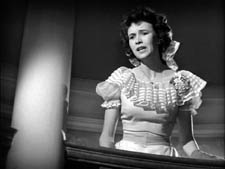
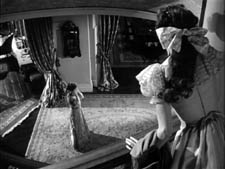
Low- and high-angle shots like this last pair recur throughout The Little Foxes, and I suspect that these are the sorts of thing Mizoguchi was invoking in mentioning Wyler’s “vertical” space. Wyler’s steep angles activate upper areas of the frame that many American directors hadn’t explored.
The act of overhearing a revealing conversation is a standard dramatic convention, but Wyler has refreshed and nuanced it. We know how it would be normally handled. We’d see either a shot showing Oscar stepping fully into the background, or a series of cuts showing first Birdie and Xan and then Oscar listening and watching. Wyler revises the standard schema, taking it for granted that we can pick up on a subtler cue than usual: just a bit of Oscar’s body intrudes.
As a result we have to be more alert. The information isn’t centered, but rather tucked into the lower left. And this option conceals Oscar’s face. Not that we’re doubting he’s angry, but delaying showing his anger builds up greater tension. Wyler, unlike today’s directors, knows when to build up to revealing things that we anticipate, making the final outburst more forceful when it comes. Further, the rest of the scene continues to deny us a clear view of Oscar’s anger, all of which gets squeezed into his gesture of slapping Birdie. It’s Birdie’s reaction that Wyler stresses, and Oscar’s contempt for her is conveyed simply by his bearing, his gesture, and his manner of stalking out of the foyer.
It’s not too much to talk about rigor here. The schemas dominating today’s filmmaking, the stylistic paradigm I call intensified continuity, would demand tight close-ups of everybody from the start. But providing them would make it harder for Wyler to raise the emotion when the startling slap comes. Maybe a contemporary director would render this spike in slo-mo, or with a wobbly handheld camera, but that tends to seem overbearing and pumped-up—as a lot of current stylistic pyrotechnics do. In any case, I’m betting that no American director today would use Oscar’s sleeve in the quietly ominous way Wyler does.
Mizoguchi’s game of vision
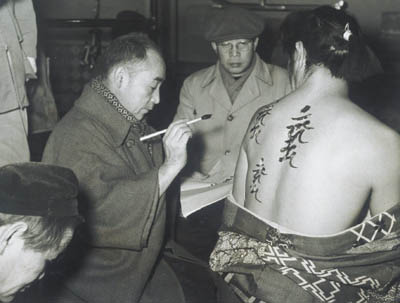
Mizoguchi Kenji, in glasses, during the making of Ugetsu.
Mizoguchi is renowned for his long takes, which are often sustained in distant views featuring considerable camera movement. In the Mizo chapter in Figures Traced in Light, I suggest that these stylistic choices spring from his effort to engage the viewer mesmerically—as he put it, “to work the viewer’s perceptual capacities to the utmost.” He asks us to downshift our attention to the finest details of the action, which he then modulates for expressive effect. I draw examples from various films across his career to show how he creates drama out of remarkably slight differences in character position, lighting, and other factors.
But what happens when he foreswears virtuoso camera movements and single-take scenes and breaks the drama up into several shots? Today, many ambitious directors seem to take pride in stretching out their takes, so cinephiles are sometimes inclined to see a cut as a loss of nerve and a concession to the audience. But I try to show in Figures that Mizoguchi sustains his concern for nuance when he creates an edited sequence. The modulation of fleeting details is to be found in his closer shots too.
In A Woman of Rumor, Hatsuko runs a teahouse that funnels customers to the geisha establishment behind it. She has tried to protect her daughter Yukiko from the shame of her profession. Hatsuko has also been cultivating a young doctor she hopes to marry, giving him money to set up a clinic. Now the doctor, Matoba, has become attracted to Yukiko. The scene I’m examining takes place during the performance of a noh drama. Hatsuko leaves the auditorium and finds Yukiko talking with Dr. Matoba.
As she passes around a screen, she hears Yukiko saying she wants to learn piano in Tokyo. Hatsuko looks left, and Mizoguchi cuts to an approximation of her optical point of view on the couple in the lounge.

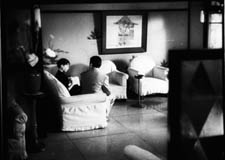
So far, so conventional. Mizoguchi seems to follow the intercutting option for treating a scene of overheard conversation. But he goes further. Having laid out the action, Mizoguchi starts the lesson in just-noticeable-details . . . with a sleeve. He cuts to a reverse shot putting Matoba and Yukiko in the foreground. Hatsuko is still back there, though. We can see her kimono sleeve on the left, poking out from behind the screen.
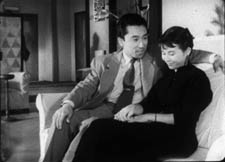
A sharp-eyed viewer might also spot Hatsuko’s shadow on a wall, in the center of the shot, over Matoba’s shoulder. This blow-up shows both the sleeve and her silhouette.
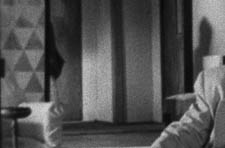
Here, friends, is one reason we want to watch films in 35mm, and projected really big.
It’s now that Yukiko says that she may leave her mother, and Matoba replies, “Maybe I’ll go too.” This is devastating to Hatsuko. The two people whom she loves most seem to care nothing for her. Her shocked reaction is given in a medium-shot showing her shifting out from behind the screen, her face partially hidden.
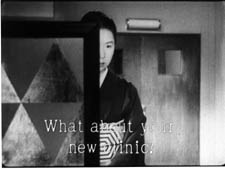
Mizoguchi has picked one variant of the overheard-conversation schema: shot of speakers/ reaction shot of eavesdropper. But he’s done so in his own way, using the barely discernible kimono sleeve to signal Hatsuko’s presence in the full shot of the couple. Likewise, the shot of Hatsuko listening is far from the usual close-up. Like other Japanese directors, Mizoguchi was fond of this arresting single-eye image. He used it earlier in his career, as shown in the first frame at the top of this entry, from Hometown (Furusato, 1930). The second frame is the last shot of his last film, Street of Shame (Akasen chitai, 1956). Quite a shot to end your career on, I’d say.
Most Japanese directors use this single-eye framing as a one-off flourish, but not Mizoguchi. The device epitomizes his demand that we concentrate on a detail. Isolating half a face gives impact to the slightest shift in the eye and eyebrow. Moreover, the split face reappears as a pictorial motif later in the scene.
As Matoba says he’ll go back to Tokyo for his doctorate, Mizoguchi cuts back to the setup for the second shot. Hatsuko moves left to sit on a chair around the corner from the sofa. This prepares for another, more prolonged game of visibility.
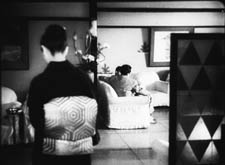
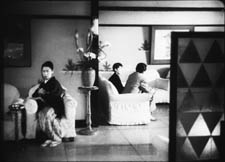
Now we get a thirty-second take of the couple on the sofa. As the scene develops, it becomes evident that Matoba is seducing Yukiko. Hatsuko slips in and out of visibility, her actions responding to and even echoing Matoba’s pressure on the girl. First, as he talks with Yukiko, we see Hatsuko’s sleeve and shoulder, between the vase and his shoulder. But as he slips his arm around Yukiko, her elbow moves aside, in an echo of his gesture.
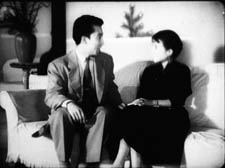
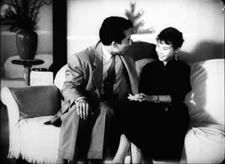
Then, when Matoba presses his attention (“We’ll help each other . . . Depend on me”), Hatsuko’s face pops into view as her fingers emerge to grip the edge of her chair. Mizoguchi then lets her face subside, again slicing it in half.
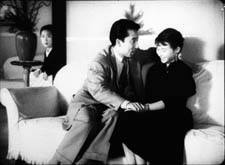
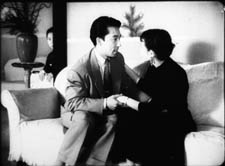
In effect, this shot replays and expands upon the tactic governing the earlier two shots. Again we get the just-noticeable presence of the sleeve, but now rhyming with the action in the foreground. And again we get the facial reaction, impeded by a vertical cutoff, but this time in the distant shot rather than in a closer view. It turns out that those first four shots were training us for this more intricate game of vision.
At the moment Hatsuko’s face is sliced in half, Mizoguchi cuts. Now he prolongs the close view as he had extended the full shot of the couple. In this thirty-second shot, we watch her reaction, played out in slight modulations—changes in her facial expression, changes in the aspect of her face that we see, and changing relations to the curling palm plant in the vase before her.
We get a new angle on Hatsuko, slightly high, as Matoba says, “I’ll tell her.” Hatsuko stands up abruptly and the camera tilts to follow her.
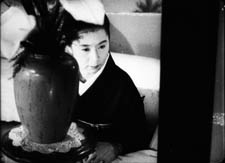
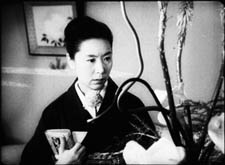
With the simple action of her rising up, Mizoguchi changes his composition sharply. Hatsuko’s position in the frame changes only a little bit, but the massive vase on the left gives way to the curling stalks on the right. Radically refreshing a shot through minimal means is one felicity of Mizoguchi’s art.
Then, as if the full import of Matoba’s betrayal dawns on her, Hatsuko lowers her head sadly. Again her eyes are split up, this time thanks to the twisting stalk. In a characteristic Mizoguchi gesture, she turns from the camera, as if ashamed to face us, but also summoning up reserves for the next emotional shift.
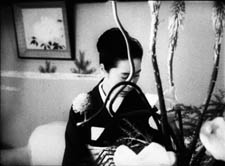
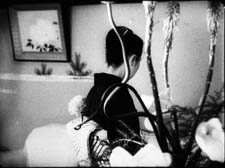
When she turns back, her face burns.
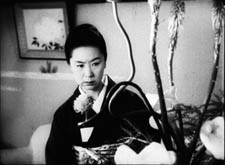
I take this to be the scene’s emotional climax. Mizoguchi could have given it to us much sooner, by having Hatsuko turn angry as she peeped out from behind the screen. Instead, his game of vision allowed him to build patiently toward this unimpeded shot of her reaction. It prepares us for the next stages of the drama, later scenes in which she will confront her patron and launch jealous accusations at Yukiko.
Now we hear the performance ending, and Hatsuko lifts her head. This phase of the scene ends when Mizoguchi cuts to audience members coming into the lounge and greeting her.
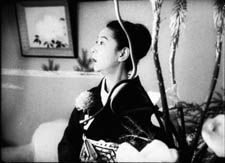
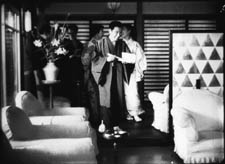
By 1954 Mizoguchi had surely seen The Little Foxes. Had he decided to redo Wyler’s virtuoso staging in his own manner?
Both directors work with similar ingredients: overheard conversation, depth shots, judicious close-ups, and partial views. But the narrational weightings differ. Wyler’s film aligns and allies us with the people talking, whereas A Woman of Rumor ties us to the listener. (3) Wyler’s eight shots take eighty-one seconds; Mizoguchi’s eight shots take about two minutes.
Wyler’s handling is brisk, tense, and remarkably nuanced within the Hollywood tradition. Mizoguchi gives us his scene more sedately, wringing just-noticeable differences out of unassertive performances and simple elements of setting. No slap here, just a drama of wounded pride, lost love, and jealousy played out in the face, back, and sleeve of Tanaka Kinuyo, shifting behind a floral arrangement. What Wyler gives us as one sharp effect, Mizoguchi turns into a delicate, prolonged game of vision.
Am I fussing over minutiae? No; Wyler and Mizoguchi did. We just have to follow where they lead. As I try to show in my essay on blinking in cinema (4), directors attend closely to things that might seem trivial. Our analysis needs to be as fine-grained as their craft and artistry.
Oh, yes: at Venice Ugetsu won the Silver Lion. Wyler had to be content with Roman Holiday’s three Academy Awards.
(1) I sketch some of the possibilities in On the History of Film Style (Cambridge: Harvard University Press, 1997), 225-227.
(2) For more on Mizoguchi’s competition with Wyler, see Figures Traced in Light (Berkeley: University of California Press, 2005), 134.
(3) I’m referring to Murray Smith’s deft analysis of what he calls alignment and allegiance in our relation to film characters. See Engaging Characters: Fiction, Emotion, and the Cinema (Oxford: Oxford University Press, 1995), Chapters 5 and 6.
(4) “Who Blinked First?” in Poetics of Cinema (New York: Routledge, 2007), 327-335.
PS 3 December: Thanks to Michael Kerpan for a name correction, and for the information that Woman of Rumor was once available on a French DVD.
PPS 27 February 2008: Good news. Now Woman of Rumor is available on the wonderful Eureka! Masters of Cinema series, along with the superb Chikamatsu Monogatari. The discs come with voice-over commentary by Tony Rayns and essays by Keiko McDonald and Mark LeFanu.
Do filmmakers deserve the last word?
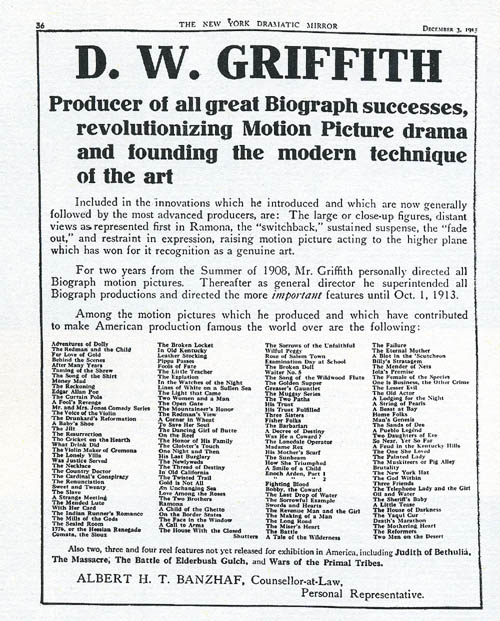
DB here:
On 3 December 1913, the above advertisement appeared in the New York Dramatic Mirror. D. W. Griffith had left the American Biograph company and set out on an independent path that would lead to The Birth of a Nation and beyond. Because Biograph never credited directors, casts, or crews, he wanted to make sure that the professional community was aware of his contributions. Not only did he point out that he had made several of the most noteworthy Biograph films; he also took credit for new techniques. He introduced, he claims, the close-up, sustained suspense, restrained acting, “distant views” (presumably picturesque long-shots of the action), and the “switchback,” his term for crosscutting—that editing tactic that alternates shots of different actions occurring at the same time.
Griffith’s bid for credit was a shrewd move for his career, and it had repercussions after the stunning success of The Birth of a Nation two years later. Many historians took Griffith at his word and credited him with the breakthroughs he listed. He became known as the father of “film grammar” or “film language.” The idea hung on for decades. Here’s the normally perceptive Dwight Macdonald, criticizing Dreyer’s Gertrud for being anachronistic:
He just sets up his camera and photographs people talking to each other, usually sitting down, just the way it used to be done before Griffith made a few technical innovations. (1)
Filmmakers believed the Griffith story too. Orson Welles wrote of the “founding father” in 1960:
Every filmmaker who has followed him has done just that: followed him. He made the first close-up and moved the first camera. (2)
In the late 1970s a new generation of early-cinema scholars gave us a more nuanced account of Griffith’s place in history. They pointed out that most of the innovations he claimed either predated his Biograph work, (3) or appeared simultaneously and independently in Europe and in other American films. Some Griffith partisans had already conceded this, but they maintained that he was the great synthesizer of these devices, and that he used them with a vigor and vividness that surpassed the sources.
That judgment seems right in part, but Eileen Bowser, Tom Gunning, Barry Salt, Kristin Thompson, Joyce Jesniowski, and other early-cinema researchers have drawn a more complicated picture. (4) Griffith did speed up cutting and devote an unusual number of shots to characters entering and leaving locales. But these innovations weren’t usually recognized as original by previous historians. More interestingly, much of what Griffith did was not taken up by his successors. His technique was idiosyncratic in many respects. By 1915 younger directors like Walsh, Dwan, and DeMille were forging a smoother style that would be more characteristic of mainstream storytelling cinema than Griffith’s somewhat eccentric scene breakdowns. Instead of creating film language, he spoke a forceful but often unique dialect.
The New York Dramatic Mirror ad coaxes me to reflect on how filmmakers have shaped critics’ and historians’ responses to their work. Hawks and Hitchcock developed a repertory of ideas, opinions, and anecdotes to be trotted out on any occasion. Today, directors write books, give interviews, appear on infotainment shows, and provide DVD commentary. We know that many of the talking points are planned as part of the film’s publicity campaign, and journalists dutifully follow the lead. (In Chapter 4 of The Frodo Franchise, Kristin discusses how this happened with Lord of the Rings.) For many decades, in short, filmmakers have been steering critics and viewers toward certain ways of understanding their films. How much should we be bound by the way the filmmaker positions the film?
Deep focus and deep analysis
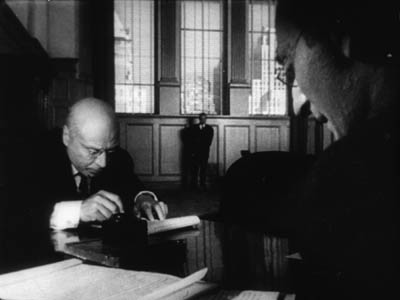
Citizen Kane (1941).
Determining intentions is tricky, of course. Still, I think that in many cases we can reconstruct a plausible sense of an artist’s purposes on the basis of the artwork, the historical context, surviving evidence, and other information. (5) This may or may not correspond to what the artist says on a particular occasion. For now, I want simply to point to one instance in which filmmakers have shaped critical uptake, with results that are both illuminating and limiting.
In the late 1940s and early 1950s, André Bazin, one of the great theorists and critics of cinema, argued that Orson Welles and William Wyler created a sort of revolution in filmmaking. They staged a shot’s action in several planes, some quite close to the camera, and maintained more or less sharp focus in all of them. Bazin claimed that Welles’ Citizen Kane and The Magnificent Ambersons and Wyler’s The Little Foxes and The Best Years of Our Lives constituted “a dialectical step forward in film language.”
Their “deep-focus” style, he claimed, produced a more profound realism than had been seen before because they respected the integrity of physical space and time. According to Bazin, traditional cutting breaks the world into bits, a series of close-ups and long shots. But Welles and Wyler give us the world as a seamless whole. The scene unfolds in all its actual duration and depth. Moreover, their style captured the way we see the world; given deep compositions, we must choose what to look at, foreground or background, just as we must choose in reality. Bazin wrote of Wyler:
Thanks to depth of field, at times augmented by action taking place simultaneously on several plane, the viewer is at least given the opportunity in the end to edit the scene himself, to select the aspects of it to which he will attend. (6)
While granting differences between the directors, Bazin said much the same about Welles, whose depth of field “forces the spectator to participate in the meaning of the film by distinguishing the implicit relations” and creates “a psychological realism which brings the spectator back to the real conditions of perception” (7).
In addition, Bazin pointed out, this sort of composition was artistically efficient. The deep shot could supply both a close-up and a long-shot in the same framing—a synthesis of what traditional editing had given in separate shots. Bazin wove all these ideas into a larger theory that cinema was inherently a realistic medium, bound to photographic recording, and Welles and Wyler had discovered one path to artistic expression without violating the medium’s biases.
There are many objections to Bazin’s argument, some of which I’ve rehearsed in On the History of Film Style. My point here is that Bazin was presenting analytical points that stemmed from publicity put out by Welles, Wyler, and especially their talented cinematographer Gregg Toland.
In a 1941 article in American Cinematographer, Toland talked freely about how he sought “realism” in Citizen Kane. The audience must feel it is “looking at reality, rather than merely a movie.” Key to this was avoiding cuts by means of long takes and great depth of field, combining “what would conventionally be made as two separate shots—a close-up and an insert—into a single, non-dollying shot.”(8) Toland defended his sometimes extreme stylistic experimentation on grounds of realism and production efficiency, criteria that carried some weight in his professional community of cinematographers and technicians. (9)
Toland’s campaign for his style addressed the general public too. For Popular Photography he wrote an article (10) explaining again that his “pan-focus” technique captured the conditions of real-life vision, in which everything appears in sharp focus. A still broader audience encountered a Life feature in the same year (11), explaining Toland’s approach with specially-made illustrations. Two samples show selective focus, one focused on the background, the other on the foreground.
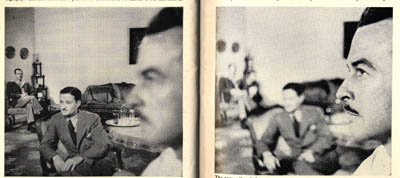
An accompanying photo shows pan-focus at work, with Toland in frame center, an actor in the background, and Toland’s camera assistant in the foreground.
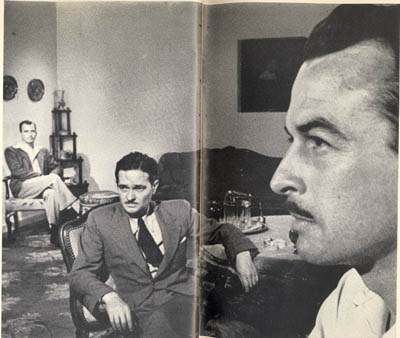
In sum, Toland’s publicity prepared viewers, both professional and nonprofessional, for an odd-looking movie.
Throughout the 1940s, Welles and Wyler wrote and gave more interviews, often insisting that their films invited greater participation on the part of spectators. In a crucial 1947 statement, Wyler noted:
Gregg Toland’s remarkable facility for handling background and foreground action has enabled me over a period of six pictures he has photographed to develop a better technique for staging my scenes. For example, I can have action and reaction in the same shot, without having to cut back and forth from individual cuts of the characters. This makes for smooth continuity, an almost effortless flow of the scene, for much more interesting composition in each shot, and lets the spectator look from one to the other character at his own will, do his own cutting. (12)
Some of this publicity material made its way into French translation after the liberation of Paris, just as Kane, The Little Foxes, and other films were arriving too. Bazin and his contemporaries picked up the claims that these films broke the rules. Deep-focus cinematography became, in the hands of critics, a revolutionary new technique. They presented it as their discovery, not something laid out in the films’ publicity.
But the case involved, as Huck Finn might say, some stretchers. Watching the baroque and expressionist Kane, it’s hard to square it with normal notions of realism, and we may suspect Toland of special pleading. Some of Toland’s purported innovations, such as low-angle shots showing ceilings, had been seen before. Even the signature Toland look, with cramped, deep compositions shot from below, can be found across the history of cinema before Kane. Here is a shot from the 1939 Russian film, The Great Citizen, Part 2 by Friedrich Ermler.
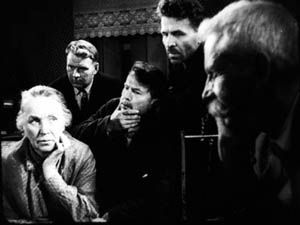
More seriously, some of Toland’s accounts of Kane swerve close to deception. For decades people presupposed that dazzling shots like these were made with wide-angle lenses.
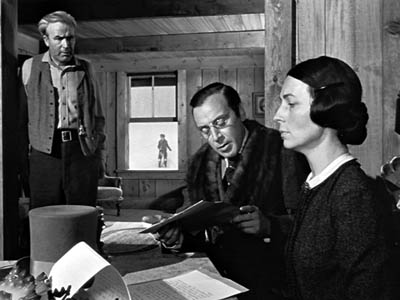
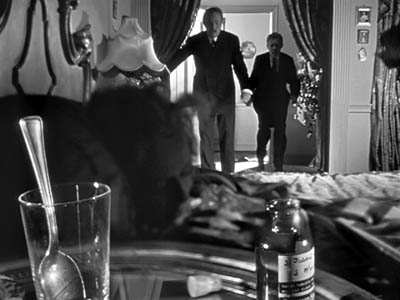
Yet the deep focus in the first image was accomplished by means of a back-projected film showing the boy Kane in the window, while the second image is a multiple exposure. The glass and medicine bottle were shot separately against a black background, then the film was wound back and the action in the middle ground and background were shot. (And even the middle-ground material, Susan in bed, is notably out of focus.) I suspect that the flashy deep-focus illustration in Life, shot with a still camera, is a multiple exposure too. In any event, much of the depth of field on display in Kane couldn’t have been achieved by straight photography. (13)
RKO’s special-effects department had years of experience with back projection and optical printing, notably in the handling of the leopard in Bringing Up Baby, so many of Kane‘s boldest depth shots were assigned to them. But here is all that Toland has to say on the subject:
RKO special-effects expert Vernon Walker, ASC, and his staff handled their part of the production—a by no means inconsiderable assignment—with ability and fine understanding. (14)
Kane’s reliance on rephotography deals a blow to Bazin’s commitment to film as a medium committed to recording an event in front the camera. Instead, the film becomes an ancestor of the sort of extreme artificiality we now associate with computer-generated imagery.
Despite these difficulties, Toland’s ideas sensitized filmmakers and critics to deep space as an expressive cinematic device. Modified forms of the deep-focus style became a major creative tradition in black-and-white cinema, lasting well into the 1960s. Bazin’s analysis certainly developed Toland’s ideas in original directions, and he creatively assimilated what Toland and his directors said into an illuminating general account of the history of film style. None of these creators and critics were probably aware of the remarkable depth apparent in pre-1920 cinema, or in Japanese and Soviet film of the 1930s. Their claims taught us to notice depth, even though we could then go on to discover examples that undercut Toland’s claims to originality.
Some little things to grasp at
I assume that Toland and his directors were sincerely trying to experiment, however much they may have packaged their efforts to appeal to viewers’ and critics’ tastes. But sometimes artists aren’t so sincere. By the 1950s, we have directors who started out as film critics, and they realized that they could guide the agenda. Here is Claude Chabrol:
I need a degree of critical support for my films to succeed: without that they can fall flat on their faces. So, what do you have to do? You have to help the critics over their notices, right? So, I give them a hand. “Try with Eliot and see if you find me there.” Or “How do you fancy Racine?” I give them some little things to grasp at. In Le Boucher I stuck Balzac there in the middle, and they threw themselves on it like poverty upon the world. It’s not good to leave them staring at a blank sheet of paper, no knowing how to begin. . . . “This film is definitely Balzacian,” and there you are; after that they can go on to say whatever they want. (15)
Chabrol is unusually cynical, but surely some filmmakers are strategic in this way. I’d guess that a good number of independent directors pick up on currents in the culture and more or less self-consciously link those to their film.
Today, in press junkets directors can feed the same talking points to reporters over and over again. An example I discuss in the forthcoming Poetics of Cinema is the way that Chaos theory has been invoked to give weight to films centering on networks and fortuitous connections. As I read interview after interview, I thought I’d scream if I encountered one more reference to a butterfly flapping its wings.
More recently, Paul Greengrass gave critics some help when he suggested that the jumpy cutting and spasmodic handheld camera of The Bourne Ultimatum suggested the protagonist’s subjective point of view–presumably, Jason’s psychological disorientation and frantic scanning of his surroundings. I expressed skepticism about this on an earlier blog entry, Anne Thompson replied on her blog, and I returned to the subject again. Any director’s statement of purpose is interesting in itself, but it should be assessed in relation to the evidence we detect onscreen.
Another recent instance: the new Taschen book on Michael Mann. The luscious pictures, mainly from Mann’s archive, are the volume’s raison d’etre, but the filmmaker seems to have placed unusual demands on the text. F. X. Feeney writes:
An earlier version of this book completed by another writer attempted (in a spirit of sincere praise) to treat Mann’s films as reactions against film traditions, as subversions of genre. This fetched a rebuke from Mann: “It’s irrelevant and neither accurate nor authentic to compare my films to other films because they don’t proceed from genre conventions and then deviate from those conventions. They proceed from life. For better or worse, what I’ve seen and heard and learned on my own is the origin of this material. Maybe the film medium by nature spawns conventions, because we all built on what’s gone before, but the content and themes of my films are not facile and derivative. They are drawn from life experience.” (16)
We have to wonder if Mann’s objection played a role in eliminating the earlier writer’s version. If that happened, it’s an unusually strong instance of a director’s holding sway over critical commentary. (17)
In the text we have, Feeney provides a chronological account of Mann’s career: plot synopses, thematic commentary, production background. There’s no discussion of broader historical trends, such as the migration of TV directors into film, the creative options available in 1980s-1990s Hollywood, the development of self-conscious pictorialism in modern film, the possibility of genre films becoming art-films or prestige pictures, or the changes in media culture or American society. All of these lines of inquiry would require comparing Mann with other filmmakers. It remains for other writers, perhaps without the director’s cooperation, to put Mann’s achievement into such contexts.
It’s always vital to listen to filmmakers, but we shouldn’t limit our analysis to what they highlight. We can detect things that they didn’t deliberately put into their films, and we can sometimes find traces of things they don’t know they know. For example, virtually no director has explained in detail his or her preferred mechanics for staging a scene, indicating choices about blocking, entrances and exits, actors’ business, and the like. Such craft skills are presumably so intuitive that they aren’t easy to spell out. Often we must reconstruct the director’s intuitive purposes from the regularities of what we find onscreen. (For examples, see this site here, here, and here.) And it doesn’t hurt, especially in this age of hype, to be a little skeptical and pursue what we think is interesting, whether or not a director has flagged it as worth noticing.
(1) Macdonald, “Gertrud,” Esquire (December 1965), 86.
(2) Quoted in Orson Welles and Peter Bogdanovich, ed. Jonathan Rosenbaum, This is Orson Welles (New York: HarperCollins, 1992), 21).
(3) Such would seem to be the case of the close-up, which of course is found very early in film history. But Griffith’s idea of a close-up may not correspond to ours. More on this in a later blog, perhaps.
(4) I give an overview of this rich body of research in Chapter 5 of On the History of Film Style. See also various entries in the Encyclopedia of Early Cinema, ed. Richard Abel (New York: Routledge, 2005).
(5) The most detailed argument for this view I know is Paisley Livingston’s book Art and Intention: A Philosophical Study.
(6) “William Wyler, or the Jansenist of Directing,” in Bazin at Work: Major Essays and Reviews from the Forties and Fifties, ed. Bert Cardullo (New York: Routledge, 1997), 8.
(7) Orson Welles: A Critical View, trans. Jonathan Rosenbaum (New York: Harper and Row, 1978) 80).
(8) Toland, “Realism for Citizen Kane,” American Cinematographer 22, 2 (February 1941), 54, 80.
(9) See the discussion in Bordwell, Janet Staiger, and Kristin Thompson, The Classical Hollywood Cinema: Film Style and Mode of Production to 1960 (New York: Columbia University Press, 1985), 345-349.
(10) Toland, “How I Broke the Rules in Citizen Kane,” Popular Photography (June 1941), 55, 90-91.
(11) “Orson Welles: Once a Child Prodigy, He Has Never Quite Grown Up,” Life (May 26, 1941), 110-111.
(12) Wyler, “No Magic Wand,” The Screen Writer (February 1947), 10.
(13) Peter Bogdanovich was to my knowledge the first person to publish some of this information; see “The Kane Mutiny,” Esquire 77, 4 (October 1972), 99-105, 180-90.
(14) Toland, “Realism,” 80.
(15) “Chabrol Talks to Rui Noguera and Nicoletta Zalaffi,” Sight and Sound 40, 1 (Winter 1970-1971), 6.
(16) F. X. Feeney, Michael Mann (Cologne: Taschen, 2006), 21.
(17) Mann’s reasoning puzzles me. He insists that his films can’t be compared to others along any dimensions, especially thematic ones. Yet in saying that his films are lifelike, he suggests that other films aren’t as realistic as his. Moreover, what about comparisons on grounds of technique, surely one of the most striking and admired features of Mann’s work? For reasons that are obscure, the director discourages any critical consideration of style; Feeney tells us that Mann hates the very word (p. 20).
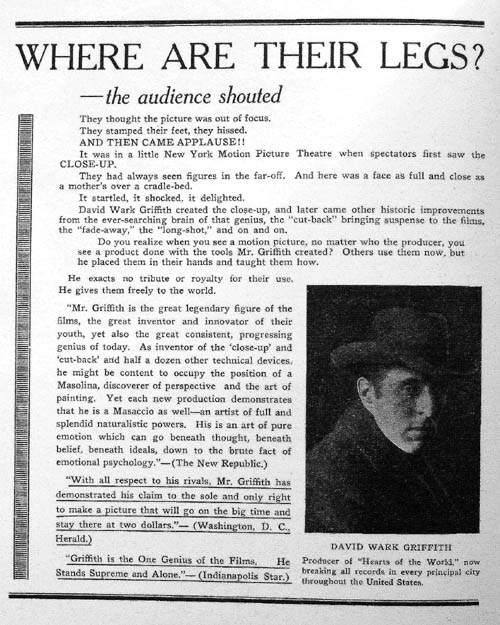
Ad in Wid’s Year Book 1918.
PS: 15 October: I’ve received a clarification from Paul Duncan, editor of F. X. Feeney’s Michael Mann book for Taschen. He expresses general agreement with my suggestions about how directors shape the uptake of their work, but he explains that the Mann book isn’t an instance of it. Here are the comments bearing on my blog entry.
In reply to my suggestion of other avenues to explore about Mann’s career:
In fairness to F.X. Feeney, he only had 25,000 words to cover Mann’s career, and all the subjects you write about are really outside the scope of the book. It sounds as though these are subjects that you would like to explore, and I can’t wait to read them in a future book or blog.
As for whether Mann exercised some control over the book’s final form, which I float as one possible explanation for its compass:
First, you speculate whether Mann caused the first version of the book to be scrapped, i.e. He exerted editorial control/censorship over the book. This is not the case, and if it was, do you think that he would have allowed F.X. to write that in the published version of the book?
In Note 17 appended to Feeney’s quote, you write: “Yet in saying that his films are lifelike, he suggests that other films aren’t as realistic as his.” If you had continued Mann’s quote, you would have reported the following: “I don’t look at the excellent French director Jean-Pierre Melville to decide how to tell the story in Thief. I meet thieves. And I guarantee you the reason Melville’s Le Samourai 1967) has authenticity, the reason Raoul Walsh’s White Heat (1949) has authenticity, is because those film-makers knew thieves, too.” I do not see any evidence here that Mann suggests that his films are more lifelike than other directors’. Only that his films stem from life like other films stem from life.
Also, in Note 17, you write: “For reasons that are obscure, the director discourages any critical consideration of style; Feeney tells us that Mann hates the very word (p. 20).” The reason Mann hates the word “style”—and I apologize for not making this clear in the book—is because after producing the Miami Vice TV show, he was forever referred to as a stylist, and the “style” of the show was all anybody ever talked about. The implication was that Mann is a director of style without substance. Subsequently, Mann has been very wary of the word, and discussion of it, because it puts undue weight on one aspect of his work.
Finally, I would like to explain a little of the working method with Mann on the book. The book was researched and written during rehearsal, filming and editing of Collateral. F.X. wrote the text and was given full access to everything that Mann had said in interviews. Mann then read and annotated the text, and this was discussed face-to-face with F.X. Most of these annotations were of a factual nature, correcting dates, being precise about the sequence of events, and to correct misinterpretations of his comments in previous interviews. However, they would also bring up new comments from Mann about his work. F.X. then rewrote some texts to include Mann’s comments, and then F.X. wrote his replies. In this way, the book became more of a dialogue between Mann and F.X. and is stronger for it I feel. So, in this case, the filmmaker did not get the last word.
I thank Paul for his clarifications, which should be of interest to all the book’s readers. On only two matters do we disagree.
First, Feeney’s book achieves what it set out to achieve, and it deserves credit for giving us valuable information about Mann in a clear, pungent style. And no one expects a Taschen book to be an in-depth monograph covering all aspects of a director’s career. But I still think that length limits don’t prevent an author from raising the contextual issues I mention. Many articles manage to address matters that go beyond the sort of career survey that Feeney provides, so there are ways to sketch such issues in an abbreviated way. I inferred, erroneously, that the choice not to tackle them could have been related to Mann’s own views on the comparative dimension that such issues tend to rely on.
Secondly, a minor matter: The fact that Mann can invoke Melville and Walsh on films about thieves suggests that a comparative perspective is valuable; he’s including himself in the company of directors who know their subjects from life, in explicit contrast to those who don’t. I didn’t include the extra sentences because I thought that they simply provided further signs of the contradiction I found in Mann’s own position—that his films can’t be compared to other directors’ works.
Bs in their bonnets: A three-day conversation well worth the reading
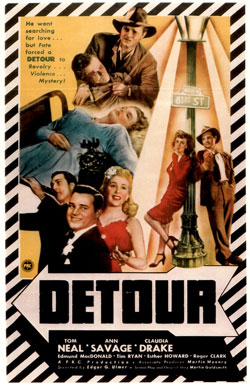
From DB:
The Film faculty and graduate students at the University of Wisconsin—Madison are a close-knit bunch. Keeping in touch via email, we exchange ideas about teaching and research, as well as passing along gossip and peculiar things that appear on the Internets. Our community includes grad students and alumni from several generations. The youngest are taking courses now; the most senior were here in the early 1970s, and they still have all their marbles.
Over three days earlier this month, there was a lightning round of exchanges on B films. With the permission of the participants, I’m posting highlights of the correspondence here because it exemplifies one way in which the Web can advance film studies.
Most film writing on the web comments on current films or video releases. Nothing wrong with that. But if you’re a researcher into film, you also want to talk about history. It’s rare to find an online debate about historical evidence and alternative interpretations of that evidence.
So to scratch my academic itch, I give you mildly edited extracts from our UW cyber-dialogue. You’ll see some hard-working professors practicing imaginative pedagogy, and you’ll find ideas for research and teaching. You’ll also see, I hope, that film studies can make progress by asking precise questions and refining them through inquiry and critical discussion.
Note to film scholars: Blogs are seldom cited in academic writing, but if you intend to use this material in your own research, it would be courteous to mention these esteemed sources, as they mention others.
To be a B, or not to be a B
First, a little background. Today sometimes we call low-budget films or just poor quality movies “B movies.” But across the history of Hollywood the term had a more specific meaning. You can find a primer at GreenCine, but here’s a little more industrial context.
During the heyday of the studio system, most theatres ran double bills—two movies for a single ticket (along with trailers, news shorts, cartoons, and the like). Very often the main feature, or A picture, was a high-budget item with major stars from a significant studio. The B film was low-budget, ran to only 60-80 minutes, and showcased lesser-known players. A B tended to be distributed for a flat fee rather than a percentage of the box office.
(I’ve just distinguished Bs in terms of its level of production; as you’ll see from the dialogue, we can think of them in other ways too.)
MGM, Warner Bros., Twentieth Century-Fox, and other major companies made B pictures as well as As. Often the B film was part of a series. Fox had Mr. Moto and Charlie Chan, MGM had Andy Hardy and Dr. Kildare. Since the most powerful studios owned theatres as well, the B film filled out the double bill with company product. Moreover, the Bs allowed studios to make maximum use of the physical plant. Sets built for an A picture could be used for a B, and actors idling between big projects could take small parts in Bs. Bs could also serve as training ground for stars, crews, and directors who might move up.
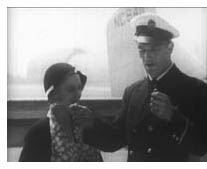 Other companies concentrated wholly on making B pictures. The most famous of these so-called Poverty Row studios are Monogram, Republic, Mascot, and Producers Releasing Corp. Besides turning out stand-alone Bs, the Poverty Row studios specialized in serials, like Don Winslow of the Navy and Hurricane Express (1932, Mascot, with John Wayne, right).
Other companies concentrated wholly on making B pictures. The most famous of these so-called Poverty Row studios are Monogram, Republic, Mascot, and Producers Releasing Corp. Besides turning out stand-alone Bs, the Poverty Row studios specialized in serials, like Don Winslow of the Navy and Hurricane Express (1932, Mascot, with John Wayne, right).
Still other studios, the so-called Little Three, hovered between A and B status. Universal, Columbia, and RKO were smaller companies, and some of their A pictures might have been considered really B’s, in terms of budget and resources. This is one theme of the conversation that follows.
As the major studios cut back production after the war, many B pictures were made as independent productions. Double bills in the US persisted into the 1960s, and Roger Corman and other producers turned out B-films for drive-ins, declining picture palaces, and rural theatres. Still, the prime years of B films were the 1930s-early 1950s. They have always been an object of admiration for cultists; recall that Godard dedicated Breathless to Monogram. Important directors like Anthony Mann and Budd Boetticher started in B production. Several Bs, notably noirs and horror films, are staples of cable and home video.
Want to know more? Here’s some essential reading: Tino Balio’s The American Film Industry, rev. ed. (Madison: University of Wisconsin Press, 1985); Douglas Gomery, The Hollywood Studio System: A History (London: British Film Institute, 2005); Todd McCarthy and Charles Flynn, eds., Kings of the Bs: Working within the Hollywood System (New York: Dutton, 1975).
Now to the question of the day.
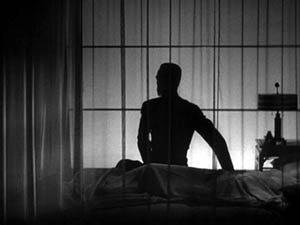
Day 1: What do I teach?
It all began on 6 February. (Cue harp music and dissolve here.) Paul Ramaeker of the University of Otago asked an innocent question….
OK, so I am running a grad seminar (or, more precisely, our closest equivalent- a 4th year Honours course) on Classical Hollywood Cinema. I want to spend time on the industry, obviously, which raises questions about what to screen for those weeks. I thought an A pic and a B pic. For the A, I was thinking about Robin Hood. For the B, I’m not sure, but I had for other purposes been considering a double bill of The Black Cat and I Walked with a Zombie. Now, the latter, I know, is a B pic; but is The Black Cat a B? It’s about an hour, which suggests a B and it’s not got a lot of sets. But it’s got Lugosi and Karloff, who surely were two of Universal’s bigger stars at the time, right? So which is it?
Any other good B pic recommendations are welcome.
The replies came fast. First, from Jane Greene of Denison University:
I do the same thing in my history class and I’ve found that Casablanca and Detour work well. It helps that most students have heard of Casablanca and a surprising number have seen it. You can point out how this “timeless classic” was very much a product of collaboration, how the star system, budget and schedule determined the look of many scenes, and it also allows you to discuss censorship… I mean self-regulation. (See Richard Maltby’s “Dick and Jane Go to 3.5 Seconds of the Classical Hollywood Cinema” in a little-known book called Post-Theory.)
Aljean Harmetz’s The Making of Casablanca is coffee-table-y, but she did consult tons of production and publicity material and there are reproductions of production documents (script pages, even a Daily Production Report!).
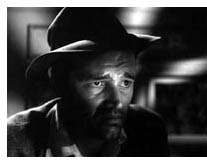 And, if yer willing to go Poverty Row for yer B Film, Detour just rocks. It’s so obviously re-using 2-3 sets and locations, has the foggiest scene ever shot, and long voiceovers that sound deep and poetic and take up half the film. The kids love it. And it could ease you gently into the waters of film noir, should you wish to go that way (and I bet you do).
And, if yer willing to go Poverty Row for yer B Film, Detour just rocks. It’s so obviously re-using 2-3 sets and locations, has the foggiest scene ever shot, and long voiceovers that sound deep and poetic and take up half the film. The kids love it. And it could ease you gently into the waters of film noir, should you wish to go that way (and I bet you do).
Leslie Midkiff DeBauche of UW—Stevens Point also shared a teaching technique.
I teach the 1930s with a colleague in the History Department and we like to create a whole program: News Parade of 1934 from Hearst Metronome News; Three Little Pigs (1933), followed by the first half of a documentary called “Encore on Woodward” about the Fox Theater opening in Detroit. It opens in 1929 and is wonderful–it has clips of late silents like Seventh Heaven, sound comes, and we end it after a woman remembers how her boyfriend proposed to her, in the balcony, during Robin Hood. We usually show the 1936 (I think, it could be 1934) year-in-review newsreel that is on the Treasures of the Archive
I set of DVDs and the feature we use is It Happened One Night. What the students like best though is the popcorn and the give-a-ways between the parts of the program: Nancy Drew and Superman, a bag of groceries with food items from 1930s–turns out to be current student food–Bisquick, Snickers, Jiffy peanut butter,Ritz crackers. The grand prize bank night equivalent is an A on the final exam. They freak! It is like they won big money.
From Notre Dame comes Chris Sieving on RKO:
In researching Lewton last year I found a few sources that argue vehemently that the Lewton-Tourneur-Wise-Robson horror films were not B films, but more like nervous As: budgets were decent, prestige factor was high, occasional name stars (like Karloff).
Another veddy interesting and perhaps more “authentic” B film, besides Detour, is Stranger on the Third Floor (1940). It contains some very bizarre and magical Peter Lorre acting, plus some people call it the “first” film noir. (Speaking of film history myths that need debunking…)
Lea Jacobs, doyenne of Film Studies here in Madison interjects:
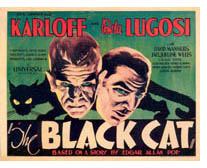 I would think The Black Cat is a B, not only because of running time but because of genre. When I was researching the distribution of B’s at RKO I was surprised by the way the horror films made by Val Lewton’s unit at RKO (many justly celebrated today) were treated as the lowest of the low–opening alongside films with titles like Boy Slaves at the small Rivoli or Rialto theaters in New York for very short runs, and later booked in and out of theaters nationally on an ad hoc basis. See my article, “The B Film and the Problem of Cultural Distinction,” Screen 33, no. 1 (Spring 1992): 1-13. I also think that Universal simply wasn’t making many A films in 1934, even with their recognizable stars.
I would think The Black Cat is a B, not only because of running time but because of genre. When I was researching the distribution of B’s at RKO I was surprised by the way the horror films made by Val Lewton’s unit at RKO (many justly celebrated today) were treated as the lowest of the low–opening alongside films with titles like Boy Slaves at the small Rivoli or Rialto theaters in New York for very short runs, and later booked in and out of theaters nationally on an ad hoc basis. See my article, “The B Film and the Problem of Cultural Distinction,” Screen 33, no. 1 (Spring 1992): 1-13. I also think that Universal simply wasn’t making many A films in 1934, even with their recognizable stars.
When I teach the B film I like to show Detour and Moon Over Harlem (now out on DVD). The latter has two really amazing scenes in a movie made for less than $10,000. But maybe that is too Ulmer heavy. Anyway you can’t go wrong with I Walked with a Zombie.
Kevin Heffernan of Southern Methodist University weighs in.
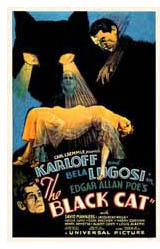 Great movies, Paul! “Cries of pleasure will be torn from” your students (as they were from our hero in S/Z).
Great movies, Paul! “Cries of pleasure will be torn from” your students (as they were from our hero in S/Z).
The Black Cat is an A picture, I think. All of the Universal horror movies ran between 65-71 mins, so this is just under their average. Also, names above the title usually point to an A, and I’m virtually certain the movie would have played a percentage (rather than a flat fee) in its initial engagement. I would imagine that a Universal horror picture sold well in subsequent run as a component in double bills, so they would be sort of de facto B pics in some situations.
And it is worth mentioning to your students, as Elder Goodman [Douglas] Gomery pointed out years ago, that the Deanna Durbin musicals were much more financially successful for Laemmle et cie than the horror movies. They’re all out on video now. Ghastly, unwatchable, wretched.
Lea Jacobs replies:
Universal is one of the little three in 1934, and, unlike today, when horror films command high budgets and garner big returns, in the 1930s horror films and sci fi were the stuff of serials and the bottom half of the double bill. I would have to see a contract before I believe it played for a percentage. One way, apart from that, to decide, is to look at where it opened in New York, how long it played and where it played subsequently in the key cities.
Doug Gomery, Resident Scholar at the University of Maryland, is succinct on I Walked with a Zombie:
RKO in the 1940s was a low budget studio and Floyd Odlum owned it. Odlum went cheap after his experiment with the likes of Citizen Kane. So it was B pure and simple.
Then Hughes bought it after the war and dabbled with his strange way of doing things.
It’s now 5:30 on the same day, but are our eager scholars tired? You have to ask?
Lea Jacobs follows up:
It is pretty safe to assume that most Universals in the 1930s were in the B range–their films were shown on the bottom of the double bills in theaters owned by the Majors. Even in the 1920s one reads Variety complaining about the cheapness of Universal’s product. A far cry from when it was taken over by Doug’s favorite Lew Wasserman.
Jim Udden of Gettysburg College jumps in, invoking the founder of film-industry studies at UW, Tino Balio:
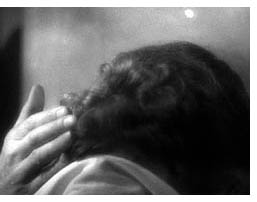 Tino does discuss this issue in Grand Design. According to him, Frankenstein and Dracula are clearly A pics, part of Universal’s strategy to break into the first-run market, since, as we all know, they had very few theaters of their own. But Black Cat is only one third the budget of Frankenstein, according to the figures in IMDB.com. Does that make it a B pic? Perhaps. Yet it seems to me that this film could still have been marketed and released like the initial Universal Horror films, riding on their coat tails, so to speak, but with less actual money invested in the production.
Tino does discuss this issue in Grand Design. According to him, Frankenstein and Dracula are clearly A pics, part of Universal’s strategy to break into the first-run market, since, as we all know, they had very few theaters of their own. But Black Cat is only one third the budget of Frankenstein, according to the figures in IMDB.com. Does that make it a B pic? Perhaps. Yet it seems to me that this film could still have been marketed and released like the initial Universal Horror films, riding on their coat tails, so to speak, but with less actual money invested in the production.
So was Black Cat more often one of these “featured” features, or was it usually the bottom half of the double bill, as Lea says? Maybe this is an AB pic?
This to me, sound like a researchable topic! (I myself have not time for this, unfortunately…)
Lea Jacobs replies:
Yes, Jim, I agree, a researchable question that I don’t have time for either. But a distinction that can be made, without research (or prior to it) is one between A/B at the level of production planning and budget and A/B at the level of distribution. Sometimes relatively “cheap” films were marketed as As (Variety usually complains about this its reviews!). Thus, to be really certain of how a film lines up, you have to look at both the budget ranges at the studio at the time of the films’ production, and the distribution pattern, including, of course, whether it was distributed for a percentage or flat fee.
Kevin Hagopian, Penn State University, comes rolling in at 10:30 pm.
* The trouble with some of the great B’s, like The Black Cat, Detour, and I Walked with a Zombie is that they’re so good that they don’t give a sense of the real purpose of the “B,” which was to hold down half of a double bill, and amortize overhead at the studios over a larger number of opportunities for revenue – that is, individual films. A comparison of scenes from an A film and a B film using the same standing sets does this nicely; I use the RKO New York street set, visible in Citizen Kane and Stranger on the Third Floor, as an example. (A great visual example I’d like to make would be Lewton’s Ghost Ship, which is said to be a script written for an existing ocean liner set, but I haven’t seen that set in another RKO film as yet.)
*I’ve often done a clip show that involves:
A. Clips from films like the Lewtons, or the Schary-Rapf films at MGM (like Pilot #5 and Joe Smith, American), or one of the series films, like a Maisie film. These films show that the resources of a big studio, such as talent, standing sets, skilled cinematography and editing departments, etc, could generate a film that, while it might have been double feature fodder, still maintains a sense of `quality’ that, perhaps, studios wanted to maintain for purposes of brand equity.
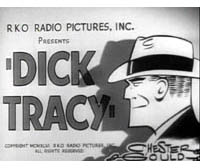
B. Clips from fairly awful B’s, like the Dick Tracys or Tim Holt Westerns at RKO, which show what could happen when questions of production value were not attended to quite so scrupulously, simply because, given the films’ titles, they were likely to draw from a market which did not make attendance decisions in the same way as patrons of, say, Pilot #5.
C. Clips from minor studio “B” westerns, ala Buck Jones. REALLY gets the point across about the relationship between production expenses and expected grosses; clearly, these films were made on a precise calculus. As films, of course, they’re nowhere near as interesting as the Lewtons or RKO “B’ noirs like The Devil Thumbs a Ride, but they work, particularly when students can’t really tell the difference between a Buck Jones, a Tom Mix, or a Three Mesquiteers – that’s sort of the point. Peter Stanfield’s work on “B” Westerns, however, shows how the signifying practices of the B Westerns, production values aside, could be truly divergent from anything in the A film canon, and worth studying. But in defense of my students, being trapped in a screening room with a true B Western at full length can be a grueling experience.
*A handout listing the films produced in a single given year by one studio, grouped by genre, and with A or B indicated in each case. 1939 is a good year to do this with, as it contains some of the few studio films students have even ever heard of. They can see how certain studios specialized in certain genres, and how B’s supported A’s in the production calendar.
*Finally, by way of an outro, of course, talking about modern equivalents of B films, and even arguing whether such equivalents exist in the film or cable marketplaces. (Jim Naremore’s chapter on direct to video “erotic thrillers” in his wonderful book on noir, More than Night, can be very helpful here.)
Our researchers retire from the field. But not for too long.
Day 2: Diving for Dollars
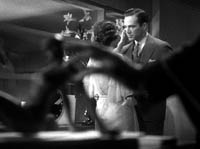
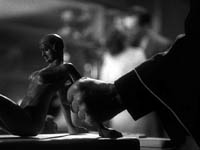
Brad Schauer, Ph.D. candidate at UW-Madison fires this off at 9:33 CST on 7 February:
Wow, what a digest I received this morning! With all this B movie talk, I couldn’t resist adding my $.02.
The Black Cat is a tricky case – it was worth flipping through some of the secondary sources to investigate (Senn 1996; Weaver, Brunas, and Brunas 1990, Soister 1999). In a sense, it’s a clear B. The budget was about $90K and was scheduled for a two-week shoot. Compare this to next year’s Bride of Frankenstein, which cost $400K and took Whale about six weeks to film. Plus, Black Cat has all the wonderful hallmarks of a quintessential B: lurid storyline, short running time, sometimes incomprehensible narrative (due in this instance to censorship), etc.
And it was devalued by the critics because of its genre and the concomitant transgressive material (the flaying scene is still shocking).
However, the film was also a big hit for Universal, its top moneymaker for 1934. Looks like it brought in rentals around $250K – which isn’t a lot, but it suggests a percentage release, at least in its initial run. Variety also said it had “box office attraction” because of the current popularity of Lugosi & Karloff, teamed for the first time. Someone would have to investigate its distribution patterns to be sure, but it kinda looks like a B picture that was sold as an A, as Lea suggested. Maybe Universal knew it could throw a cheap movie out there and it would succeed based on the popularity of the genre and the stars. It’s a kind of precursor to all those low-budget, highly-profitable horror films like Halloween and Saw. So for me it’s about 4/5th B, 1/5th A.
Would I show it as an example of a B? As Kevin Hagopian mentioned, it’s really much too good to be a truly representative example, but students will probably like it more than a Dr. Kildare movie or something. If you really want to sock it to them, dig into the Sam Katzman filmography. Try one of the Jungle Jims or the Lugosi Poverty Rows.
David already mentioned the real gems of the studio Bs, the Motos. The Chans are great too. (I can even watch the Monogram Chans, although the Karloff Mr. Wongs can be a real slog.) As far as other mystery series go, the Universal Holmes films are extremely well done, the Dick Tracys, Perry Masons, and Torchy Blaines are a lot of fun, and I have a soft spot for the Falcon films due to AMC early morning reruns in my childhood. The Kitty O’Day mysteries are on my “to watch” pile, but I’m not optimistic. Follow Me Quietly (1949) also comes to mind as a great B-noir.
And also, the Thin Man movies weren’t really Bs. Not responding to anyone – just needed to get that out there. Closer to Bs would be MGM’s Sloan mystery knockoffs, which are fun too (especially Fast and Furious, which is fortunate enough to have Rosalind Russell).
Whew, thanks for reading if you made it this far.
As a new day dawns on Texas, Kevin Heffernan has more thoughts.
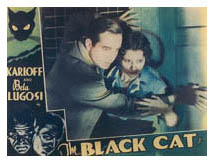 Thanks for the info, Brad. Yes, Black Cat is a curious hybrid case. For a “truer” example of a Karloff/Lugosi B from Universal, see The Raven from the following year–most notably in its use of fairly minimal, obviously left-over sets (nothing like the very bold production design of Black Cat). And, although I recall that Kristin is a Lew Landers fan (didn’t she call him “lightly likeable at least” in Breaking the Glass Armor?), his name was somewhat synonymous with quotidian program pictures in the 30s and 40s.
Thanks for the info, Brad. Yes, Black Cat is a curious hybrid case. For a “truer” example of a Karloff/Lugosi B from Universal, see The Raven from the following year–most notably in its use of fairly minimal, obviously left-over sets (nothing like the very bold production design of Black Cat). And, although I recall that Kristin is a Lew Landers fan (didn’t she call him “lightly likeable at least” in Breaking the Glass Armor?), his name was somewhat synonymous with quotidian program pictures in the 30s and 40s.
My assertion that Black Cat was an A referred to my understanding of the terms of its first-run distribution . But I actually had little evidence, I have discovered, as I looked over my notes on the movie from Tino’s seminar a few years back.
Lea and Doug’s observations about Universal’s “Little Three” status and the general role its horror pictures played in the larger patterns of distribution seem spot on to me and of course became more prevalent (inflexible, even) in the post-Laemmle years. The only exception to this that I can think of was Son of Frankenstein, which was U’s entry in the superproduction cycle of 1938-39 (stars on loan from other studios, spectacular production design, initial plans to shoot in Technicolor, etc), but that movie was really the last gasp of the A horror pic at the studio, I think.
And at 10:10 AM CST Lea Jacobs is back at the keyboard.
I guess Brad has the last word on The Black Cat. Nothing like doing the research.
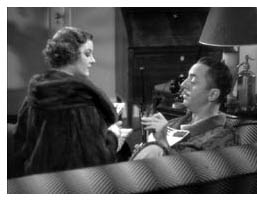 Now about the Thin Man series. In the essay on film budgets at MGM that appeared a few years back, I recall that these films were in the “B” range for MGM (about $250,000). (See H. Mark Glancy, “MGM Film Grosses—1934-1948: The Eddie Mannix Ledger,” Historical Journal of Film, Radio and Television 12, 2, 1992: 127-144.) This is a lot of money relative to what other studios were spending on B films, of course, but all of MGM budget ranges were high relative to the other majors (the average MGM A was between $700,000 and $1 mil as I recall). So I agree that the Thin Man films are elegant and well dressed and don’t fit anyone’s conception of a B, but at least when considered from the perspective of film budget categories at MGM, wouldn’t these count as Bs? Or, put another way, what would you count as an MGM B?
Now about the Thin Man series. In the essay on film budgets at MGM that appeared a few years back, I recall that these films were in the “B” range for MGM (about $250,000). (See H. Mark Glancy, “MGM Film Grosses—1934-1948: The Eddie Mannix Ledger,” Historical Journal of Film, Radio and Television 12, 2, 1992: 127-144.) This is a lot of money relative to what other studios were spending on B films, of course, but all of MGM budget ranges were high relative to the other majors (the average MGM A was between $700,000 and $1 mil as I recall). So I agree that the Thin Man films are elegant and well dressed and don’t fit anyone’s conception of a B, but at least when considered from the perspective of film budget categories at MGM, wouldn’t these count as Bs? Or, put another way, what would you count as an MGM B?
Doug Gomery adds in re MGM B-pictures:
Nicholas Schenck was no great man, but he ran Loew’s/MGM from 1927 to 1954. To him the Thin Man series were Bs from his studio. Remember block booking? These simply made MGM a more attractive package. The question of A v. B is at its heart a budget decision and then a release one. The New York-based men, like Schenck, made those decisions.
Day 3: B Mania Subsides; some answers, more questions
8 February: Brad Schauer revisits Nick and Nora:
 Real quick about the Thin Mans before I run to lecture: I know I was being a bit contentious when I said they weren’t Bs. Lea and Prof. Gomery are absolutely right that if you go by budget, they’re Bs…at least initially. But by the time we get to Another Thin Man (1939), the budget is up to $1.1 mil, only a couple of Gs less than Ninotchka. 1944’s Thin Man Goes Home is budgeted at $1.4 mil, only about $500K less than Meet Me in St. Louis (!).
Real quick about the Thin Mans before I run to lecture: I know I was being a bit contentious when I said they weren’t Bs. Lea and Prof. Gomery are absolutely right that if you go by budget, they’re Bs…at least initially. But by the time we get to Another Thin Man (1939), the budget is up to $1.1 mil, only a couple of Gs less than Ninotchka. 1944’s Thin Man Goes Home is budgeted at $1.4 mil, only about $500K less than Meet Me in St. Louis (!).
Another reason they don’t seem like Bs to me is that they were consistently among the top grossers for MGM in the ’30s. But so were the Andy Hardys, you might argue, and they’re clearly Bs.
Except…from what I could tell from analyzing the distribution patterns of the ’35-’36 season (not done this morning, don’t worry), After the Thin Man played in major first run theaters, and hardly ever with a second feature until it hit the nabes (neighborhood theatres). It was distributed like a big deal A, and you can sense the exhibs’ excitement in the trade press that another Thin Man installment was coming out.
Finally, we can look at the running times. MGM’s Bs were sometimes longer than other studios, but the first sequel After the Thin Man is nearly two hours long. Compare that to MGM’s Sloan mysteries (Thin Man knock-offs), which clock in at 75 minutes each.
So, like The Black Cat, the Thin Man films seem an unusual case. The first installments may have been budgeted as Bs, but as the series caught on, it was treated like an A property, both in terms of production and distribution – compared to the Andy Hardy films, for instance, whose budgets remained quite low for the entire series.
Although I think the Hardy films were often exhibited as the top of a double feature, but that’s another story.
I kinda feel like lecturing on this stuff this morning instead of the continuity system, although I’m not sure the students will want to hear about distribution patterns at 8:30 a.m.
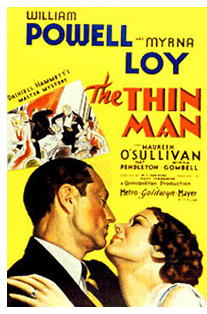 Lea Jacobs’ fingers fly over the keyboard a few moments later:
Lea Jacobs’ fingers fly over the keyboard a few moments later:
This is very interesting, Brad. I wonder if any of this could be correlated with William Powell and Myrna Loy’s salaries? That is, maybe the series made them stars (I am pretty certain that they were not prior to the first of the series). Higher budgets for later Thin Man films might have been a function, not only of more expensive settings and shooting practices, but also of MGM raising the stars’ pay.
Anyway, it might be worth looking at the publicity attached to the two stars over the course of the series and see if it increased and if it changed. I don’t know of any source that would tell you what they were paid (at least any source that can be trusted) although contracts might exist at AMPAS.
And then, of course, there is the question of whether or not the cutting rate went down over the course of the series…
This last remark refers to an email entry of my own, sent about the same time:
I have another idea about how to spot a B. It isn’t infallible, but it might serve as an index. I’m thinking Average Shot Length.
Oho, you think, here we go again. But hear me out.
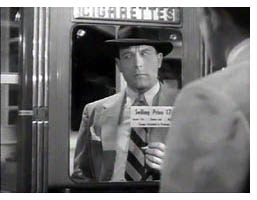 Last night I watched THE DEVIL THUMBS A RIDE, a 62-minute RKO item from 1952, directed by Felix Feist. Laurence Tierney is the most recognizable name in it, and if you know him only from RESERVOIR DOGS, you might not recognize him. Good suspense, very few sets (lots of car driving with background process plates), familiar character actors wandering in to do a bit part (including Harry Shannon, aka Charles Foster Kane’s father). A surprisingly violent twist at one point. Even the title tells you you’re watching a B.
Last night I watched THE DEVIL THUMBS A RIDE, a 62-minute RKO item from 1952, directed by Felix Feist. Laurence Tierney is the most recognizable name in it, and if you know him only from RESERVOIR DOGS, you might not recognize him. Good suspense, very few sets (lots of car driving with background process plates), familiar character actors wandering in to do a bit part (including Harry Shannon, aka Charles Foster Kane’s father). A surprisingly violent twist at one point. Even the title tells you you’re watching a B.
And 6.0 second ASL.
We found in our Hollywood book [The Classical Hollywood Cinema], and pretty reliably since, that during the 1930s-1950s the Hwood norms ranged from 8-11 seconds per shot. But those samples were drawn, I increasingly realize, from mostly A pix, because in the vast initial filmography we compiled, what we found in archives tended to be A pix. Only William K. Everson had a substantial collection of B titles on our first list, more even than the Library of Congress.
So maybe Bs tend to be cut faster? Here are some other ASLs from the 1930s, from B or B+ items: Murder by an Aristocrat, 6.3 seconds; Nancy Drew and the Hidden Staircase, 6.8; Indianapolis Speedway, 5 seconds; Tarzan the Ape Man, 6.6 seconds; Tarzan Finds a Son, 3.6 seconds!
From the 1940s: Parole Fixer, 6.6 seconds; Chain Lightning, 6.3; Framed, 6.3.
Now this mini-sample has skewing problems of its own–lots of mystery and action pictures. We’d need to test it with other genres. Can there be fast-cut musicals? (Actually, yes; Footlight Parade.) Comedies? (Yeah, Duck Soup.) Melodramas? (Yep, Mr. Skeffington.) Still, I don’t have enough from any genres to say much of substance. As for our two big horror examples, The Black Cat falls in the A-picture range (8.5 seconds), while The Raven is much faster cut (5.7 seconds).
And what about the real Bs–the Westerns from Monogram et al? Plenty of them play on TCM and we have tons sitting in the Wisconsin Center for Theater Research, but I confess to having watched only a handful and never counted shots. Also, films with lots of stock footage (travel, racetracks, jungle animals, etc.) tend to be cut faster…and we know that Bs use lots of stock footage.
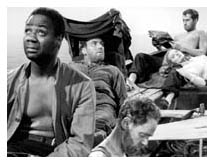 Interestingly, of major directors I’ve sampled, Hitchcock’s ASLs come closest to the ‘B’ touch. Selznick famously told Hitchcock to slow down the pace because his British films were too “cutty”; was there an unspoken belief that fast cutting was a little downmarket if you were making A pictures? Hitchcock sometimes cut fairly fast (until Rope and Under Capricorn, of course): 6.4 seconds for Lifeboat (on right), 7.3 for The Paradine Case, 6.8 for Notorious.
Interestingly, of major directors I’ve sampled, Hitchcock’s ASLs come closest to the ‘B’ touch. Selznick famously told Hitchcock to slow down the pace because his British films were too “cutty”; was there an unspoken belief that fast cutting was a little downmarket if you were making A pictures? Hitchcock sometimes cut fairly fast (until Rope and Under Capricorn, of course): 6.4 seconds for Lifeboat (on right), 7.3 for The Paradine Case, 6.8 for Notorious.
ASL can’t be an infallible detector because there are some Bs with ordinary ASLs, and a few with longish ones. Detour clocks in with an unusually lengthy 14.3 second ASL. Joseph H. Lewis’ The Big Combo (1954), made for Allied Artists (the revamped Monogram), boasts an ASL of 14.6 seconds and has many single-shot sequences (though given its cast and technical credits, it’s arguably a B+). Still, most marathon ASLs seem to come in A pix by Minnelli, Preminger, Wilder, and their peers.
What makes this stuff interesting is a long-standing assumption that because of short shooting schedules, B films couldn’t afford many camera setups. I think there’s an unspoken belief that directors used longer takes to get more footage per day. The shot length averages suggest the opposite: B films can use lots of shots, and a surprising variety of setups.
This may also suggest a difference between A studios making B pictures and Poverty Row studios making only B pictures. Again, my sample is slanted toward the former. Nevertheless, although faster than normal cutting isn’t a necessary condition of a studio-era B picture, it may be a symptom of one. If other indicators point toward a B, and you’ve got an ASL of less than 7 seconds, that could strengthen the case.
Scott Higgins of Wesleyan University raises a new question about my ASLs:
Fascinating. Are shot scales different as well? Might editing compensate for cheaper mise-en-scene? In any case, this is good evidence that staging takes time!
Coming full circle
On 8 February, at 8:00 CST, Paul Ramaeker, who started it all two days earlier, writes:
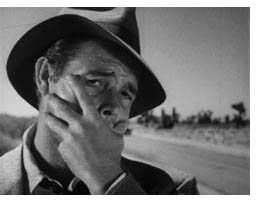 Wow! Thanks to everyone for their input on this; now I just have to sort through everyone’s arguments and make a judgment call (given the degree of controversy over the question). I have to say, though I have now been convinced to use Detour as one of my screenings for that week, so as to have an example of Poverty Row, it would seem that either Black Cat or Zombie would work (as well as a Moto, which I hadn’t thought of at first), not least because there is some element of ambiguity in both cases that would be fodder for discussion.
Wow! Thanks to everyone for their input on this; now I just have to sort through everyone’s arguments and make a judgment call (given the degree of controversy over the question). I have to say, though I have now been convinced to use Detour as one of my screenings for that week, so as to have an example of Poverty Row, it would seem that either Black Cat or Zombie would work (as well as a Moto, which I hadn’t thought of at first), not least because there is some element of ambiguity in both cases that would be fodder for discussion.
I have to say, though, I think the reminders about the status of the Little 3, as well as the budgetary info, are kinda persuasive in the case of The Black Cat. And while I’d hate to lose Zombie, I can see some value in screening two films at different production levels by the same director, Ulmer in this case. There may well be such a thing as too much Ulmer, but if anyone could possibly object to a Black Cat/Detour double bill, they’d have to be kicked out of the class.
Cheers to all!
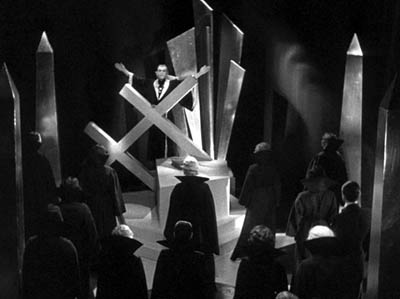
Weekly colloquium meeting of the Film area, UW–Madison
Walk the talk
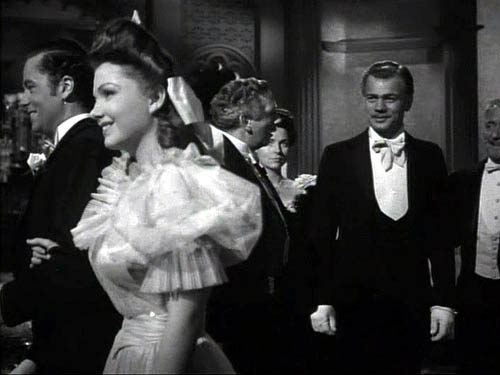
The Magnificent Ambersons.
“It’s only history,” Jack Valenti is reported to have said when allowing scholars access to MPAA files. (1) After studying Hollywood for over thirty years, I should be used to the ways in which trade journalists (and some critics) forget or ignore historical precedents in moviemaking. But I still get bug-eyed when I encounter something like the Variety piece on TV director Tommy Schlamme (Studio 60 on the Sunset Strip).
The subhead tells us that this DGA nominee is known for his “hallway shots.” That gets my interest.
I lose interest fast. The writer tells us that Schlamme
developed the “walk and talk” on Sports Night and then mastered it on The West Wing.
The shot—which features two or more actors moving from one location to another on the set, often from one office to another via a hallway—has become a Schlamme signature.
The first sentence could be read as saying that Schlamme invented the walk-and-talk. Since I spent a little time studying this technique in The Way Hollywood Tells It, my inner film historian cries out, Aarrgh. Long before Sports Night (aired 1998-2000) and The West Wing (1999-2006), movies were developing such bravura shots.
The oblique view
In the prototypical walk-and-talk, two or more characters advance, and the camera tracks along, keeping them centered as they move through the environment. Such shots are quite uncommon in the silent cinema, but they emerge in 1930s films from many countries.
They were truly “signature shots” for Max Ophuls and the lesser-known Erik Charell. In Charell’s captivating The Congress Dances (1931) Lillian Harvey sings while a carriage takes her through an entire town and into the country, all in flowing tracking shots. Call it a ride-and-sing.
If that’s not as pure an instance as you’d like, we can find nice ones during a street scene of The Thin Man (1934). A more somber example occurs in Mizoguchi Kenji’s Story of the Last Chrysanthemums (1939), with the camera in a river bed angled upward at the couple it follows.
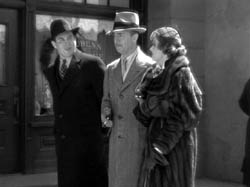
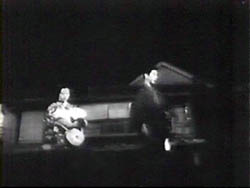
Usually such traveling shots from the 1930s and 1940s are shot obliquely to the actors. That is, the performers are seen in a ¾ view, and they walk along a diagonal path with respect to the frame edges; the camera moves on a similar trajectory. Sound cameras were mounted on dollies that usually ran on tracks. Framing the actors head-on raised problems with this gear. Performers couldn’t walk smoothly if they were stepping within rails, and there was a risk that the rails in the distance might appear in the frame. It was simpler to set the camera at an oblique angle so that actors could walk unimpeded and the tracks wouldn’t be seen. Directors continued to use this framing into the 1950s, as in Welles’ Othello (1952) and Fuller’s Forty Guns (1957). Both are unusually long takes; in the second, poor Gene Barry seems to be panting to keep up with the other men.
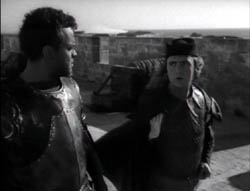
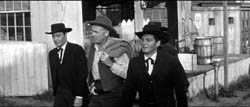
Back off
Today’s walk-and-talk is more likely to be a head-on framing, with the camera retreating from the actors. (More rarely, it dogs them from behind.) With a retreating Steadicam, you don’t have to worry about glimpsing the ground or floor behind the actors, in the distance, since there are no track rails to be exposed. Again, though, we have some precedents, most famously the splendid camera movements, evidently executed with a crane, in the ball sequences of The Magnificent Ambersons (1942), when George and Lucy stroll through the party.
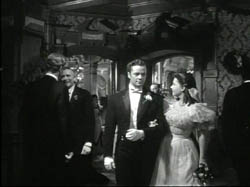
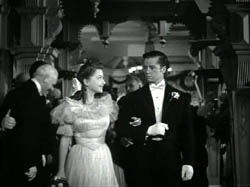
When location shooting became more common in the 1940s and 1950s, cameras could be supported on more versatile dollies that didn’t require track rails, and these reverse-tracking shots become a bit more common. Kubrick, highly influenced by Welles and Ophuls, captured his officers striding through the trenches of Paths of Glory (1957). Vincent LoBrutto’s information-packed book (2) tells us that Kubrick’s dolly rolled backward on the planks that the actors walked on (authentic details, as boards were indeed used in the muddy trenches). Godard’s long traveling through the office lobby in Breathless (1960) was shot from a wheelchair.
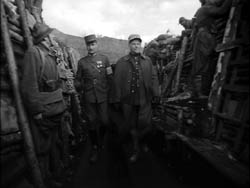
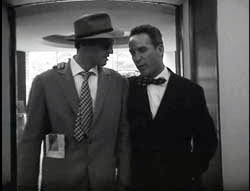
Such head-on (and tails-on) shots can be found in several films well into the 1970s, as in Arthur Hiller’s The Hospital (1970). In fact, hospitals, police stations, and other sprawling institutional spaces seem to invite this approach.
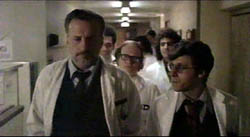
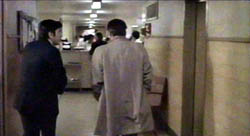
By the 1980s, these shots proliferate in American films largely because the Steadicam makes them easy. One famous example is De Palma’s Bonfire of the Vanities (1990), which follows the drunken Peter Fallow through a hotel as he picks up and drops off many other characters.
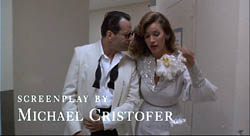
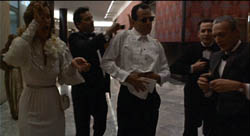
Today such shots are very common in both high- and low-budget films. Schlamme’s “signature” device seems to be in pretty wide circulation. At best it’s a convention, at worst a cliché.
They’re called actors; let them perform action
I argue in The Way Hollywood Tells It that walk-and-talk is one of two principal staging techniques of contemporary Hollywood. The other, usually called stand-and-deliver, plants the characters facing one another and simply cuts from one to the other. The scene is built primarily out of singles (shots of only one actor) or over-the-shoulder framings. Here’s a typically static dialogue scene from The Matrix Revolutions (2003).
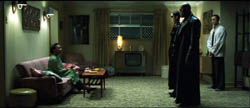
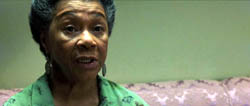
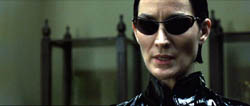
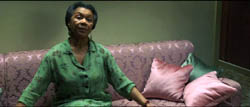
Both stand-and-deliver and walk-and-talk began in the studio era, decades ago, but then there were other options as well. Directors cultivated smooth, unobtrusive blocking tactics that moved characters in ways that reflected the developing scene. The actors had to perform with their whole bodies, and bits of business motivated them to circulate through the setting and turn toward or away from the camera. One example given earlier on this blog is from Mildred Pierce; here’s another, from the program picture Homicide (1949).
Detective Michael Landers has a hunch that the purported suicide of a former sailor is really murder. He has to persuade Captain Mooney to let him pursue some leads out of his jurisdiction. Today this might be played out in a stand-and-deliver session, with both men seated and shot/ reverse-shot cutting carrying the scene. But the director Felix Jacoves decides to let his actors earn their money through ensemble staging, not merely line readings. Here are just three shots from the middle of the scene that illustrate my point.
Landers stands at Mooney’s desk and gets a refusal. As he turns away to the left, Mooney walks to the rear files to put the papers away.
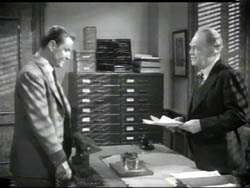
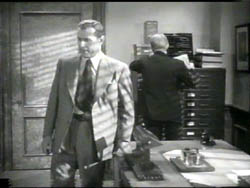
As they’re retreating to the opposite ends of the screen, Landers’ partner Boylan, who’s been offscreen for this phase of the scene, strides into the center and pauses at the door. The result of this choreography is both a balanced three-point composition and a chance to let us observe Boylan’s skeptical reaction to Landers’ next plea.
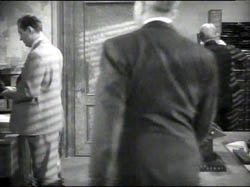
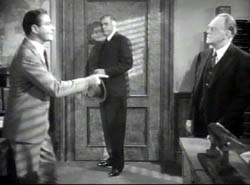
The camera tracks in as Landers approaches Mooney. Boylan shifts closer as well. What seems somewhat stagy as we analyze it doesn’t look obtrusive on the screen, because we’re following Landers’ arguments and watching the older men’s reactions. The closer framing and the position of the men, now face to face rather than separated by a desk, raises the dramatic pressure. As Landers pauses, Mooney folds his arms—a simple piece of body language that lets us know he’s still resisting.
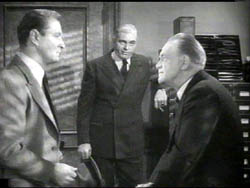
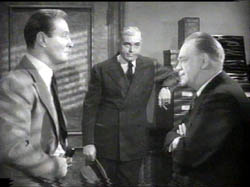
Now a cut to Mooney, in an OTS framing, stresses his continued resistance as he tells Landers off, and a reverse shot gives Landers’ angry reaction.
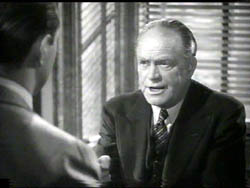
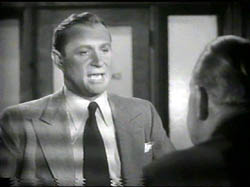
Interrupting the sustained take, the shot/ reverse shot cuts have gained more emphasis than if they were part of a string of OTS shots. Jacoves has saved his cuts and closer views for a moment that raises the stakes visually as well as dramatically.
I’m not claiming that this is a brilliant stretch of cinema. (But you have to like a plot in which the hero defeats the killer by denying him access to insulin.) It’s just that the sequence activates, in a way that directors once took for granted, aspects of film art that we don’t find too often nowadays. Once you didn’t have to choose between Steadicam logistics and static dialogue; there is a very wide middle ground if you’re willing to move actors around the set and give them some body language and prop work. No need for a walk-and-talk here.
Schema and revision
The Variety article explains that Schlamme utilizes his long walk-and-talks to save time and money. But directors in the studio era shot their fully elaborated scenes like that in Homicide to be economical as well. If actors know their lines and hit their marks, playing out pages of dialogue in a few sustained setups can be very efficient; the Homicide full shot consumes 45 seconds. I’d argue that most contemporary directors have never learned to stage scenes this way. It’s a lost skill set. I make the case in more detail in Figures Traced in Light and The Way Hollywood Tells It.
To some extent, however, another skill set has emerged. Some walk-and-talks in The West Wing and other programs have an extra feature that the Variety writer and I haven’t mentioned. Often character A and B are walking toward us down the corridor, then B drifts off and C catches up with A. A and C walk for a while, then A peels off and C picks up somebody else, and so on. This approach is suited to multiple-protagonist dramas. You can show the plotlines crossing and separating.
I’m no TV historian, but I think that this technique showed up on St. Elsewhere (1982-1988), and it’s definitely on display in ER (1994-). Hospitals again. I think we also find this mingling/ separating choreography in contemporary film, but I can’t recall many examples in earlier eras. You could argue that one of the shots in the Ambersons’ ballroom does this, though I don’t think it’s a pure instance. (The principle of overlapping character actions is at work in many Renoir films, most famously in the final party melee in Rules of the Game, but Renoir doesn’t employ what we’re calling a walk-and-talk.) Did movies pick up this intertwined walk-and-talk from TV or vice-versa? I don’t know. If you do, drop me a line!
In On the History of Film Style and Figures Traced in Light, I argue that stylistic change in filmmaking often follows a logic of what art historian E. H. Gombrich calls schema and revision. (3) A pattern or practice becomes standardized, but then creators extend it to new situations or find new possibilities in it, and they modify it.
Camera movements have long been used to link characters. For instance, when Nick Charles circulates drinks in The Thin Man, Van Dyke tracks leftward to follow him from guest to guest.
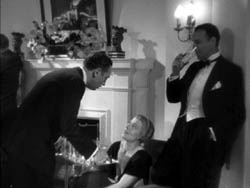
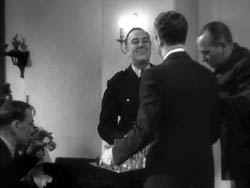
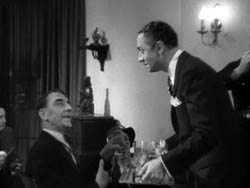
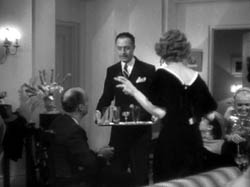
So maybe in the 1980s and 1990s, when ensemble stories had to balance attention among several major characters, directors blended the multiple-interaction aspect of lateral camera movements with the schema of the advancing walk-and-talk. The result makes characters move in and out of each others’ orbits along a single trajectory. Whoever came up with this device, I’d speculate that it arose from the realization that the backing-up walk-and-talk could be repurposed for dramas following the fates of several protagonists.
It’s only history, but it matters if we want to understand stylistic continuity and change.
(1) Thanks to Richard Maltby for passing this along.
(2) Vincent LoBrutto, Stanley Kubrick: A Biography (New York: Fine, 1997), 141-142.
(3) E. H. Gombrich, Art and Illusion: A Study in the Psychology of Pictorial Representation (Princeton, N. J. Princeton University Press, 1960), especially Chapter III.













